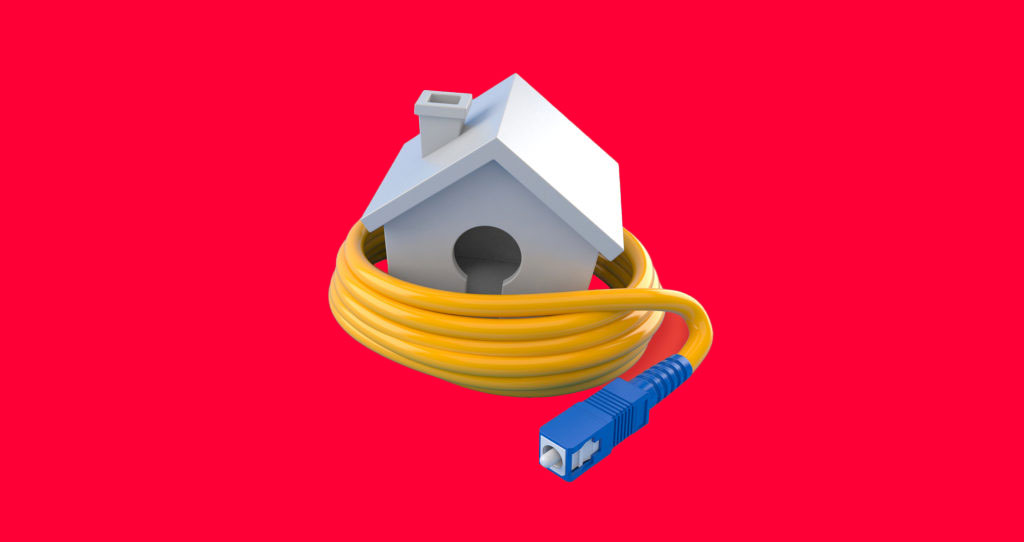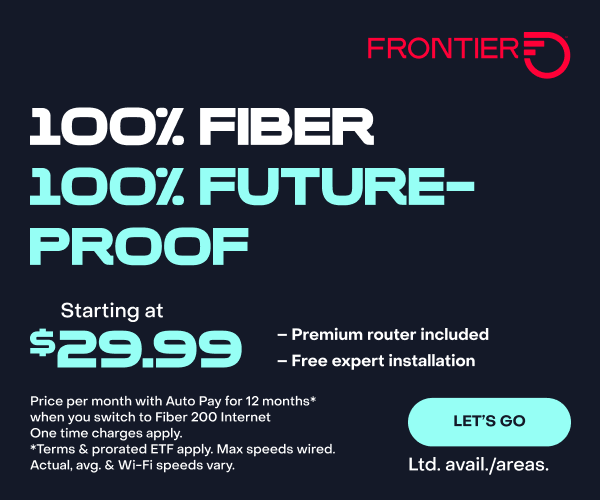
What’s Fiber to the Home? To the Curb? To the Node?
18 commentsWhen you find out that fiber is coming to your neighborhood (at last!), you’ll want to see how it’s being delivered.
While internet service providers (ISPs) say they’re providing 100% fiber networks, fiber to the curb (FTTC) and fiber to the node (FTTN) options don’t actually provide that fiber all the way to your residence. Just be aware that fiber to the home (FTTH) is the one and only option that provides pure fiber directly to your home without using any copper wiring along the way.
Fiber to the home (FTTH)
This is the fiber installation option you want to look for, as it will give you the best performance. Unlike the other options, fiber is installed directly into your home without using any coaxial cables or copper wiring, so it provides the highest bandwidth, fastest speed and greatest reliability.
Here’s how FTTH—also called fiber to the premises (FTTP)—works: The fiber is installed from your ISP’s closest central office to a box, called an optical network terminal (ONT), that’s placed inside or outside your home. The ONT converts the fiber optic signals to electronic signals that are transmitted to your router via an ethernet cable.
Per the FTTH Council, an organization that advocates for fiber in homes, in order for an installation to be classified as FTTH, the fiber must cross the property line and end either inside the home, on an outside wall of the home or within about 6.5 feet of an external wall on the property.
The one downside to FTTH is that it isn’t yet widely available. There’s promising news, however. Fiber passes more than 54 million U.S. homes, and with a growth rate in fiber installation of about 10% per year, researchers predict that fiber could be available in 35% of U.S. households over the next decade.
In addition, thousands of FTTH projects are currently in development all around the world, according to the Fiber Optic Association (FOA), so FTTH may be available to you in the not-so-distant future.
Fiber to the curb (FTTC)
No, fiber isn’t installed inside that low concrete border separating your property from the street.
“Curb” in this case refers to a utility pole or cabinet that contains a junction box called a node, in which the main fiber optic cable from your ISP’s central office is installed.
Inside the node, the fiber optics are converted into electronics that are transmitted using existing coaxial cables or copper telephone lines to your home—as well as to other homes within about 1,000 feet of the node. Fiber internet providers call the connection from the node to your home “the last mile,” although it’s not necessarily that exact distance.
The quality and age of your home’s copper wiring may affect your internet connection. For example, homes with older copper wiring may have less available bandwidth.
Fiber to the node (FTTN)
Also called fiber to the neighborhood, this type of delivery is similar to FTTC, with one important difference.
Instead of just your immediate neighbors, FTTN provides service to several hundred homes located within an approximately one-mile radius of the node utility pole—so in this case, “the last mile” is accurate.
The farther away your home is from the node, the farther the data must travel through copper wiring, which may result in a slower and less reliable connection.
Frontier Fiber is built for the way you live today—and tomorrow
If you’re still on the lookout for the right ultra-fast internet connection for streaming, gaming, working from home and running your smart home—all with enough bandwidth for everybody, find out about Frontier Fiber. Then check our Fiber Expansion page to see when it’s available at your address




Frontier fiber is coming to my home in March and I would like to buy a router vs having the monthly rental. So what is the best router that works with frontier fiber and do I need to run any fiber, coax or cat 5 myself from the frontier box outside to my router inside or will frontier handle that run.
Hi David,
How exciting that our fiber will soon be available in your neighborhood! These are some great questions. We currently have promotions that include our standard Wi-Fi router at no charge or monthly fee, or a 2 access point Eero 6 mesh included with our Gig service. Beyond that we’re unable to make any specific recommendations and always advise using the hardware we provide direct support for. If you’re an IT pro and able to support and configure your own network, then there is a wide variety of top-notch choices out there from leading vendors like Amazon’s Eero, Google’s Nest, Netgear’s Orbi, Ubiquiti just to name a few. One thing all of these have in common, they’re mesh networks, and that’s definitely the way to go for superior coverage and elimination of any dead zones within a home. It’s also worth noting that the performance of Wi-Fi will always be outmatched by a wired connection, so when possible, having stationary devices wired is always ideal.
As for installation cabling requirements, our technicians are generally able to care for that on install day. The fiber install consists of a fiber line connection from either a buried or aerial drop to a device called an Optical Network Terminal (ONT). The ONT requires power and has an Ethernet connection. This device can be located in a weatherproof enclosure on the outside or wall mounted inside of a home (often in the garage). From there an Ethernet connection is made to the router or the Ethernet may be converted to existing coaxial wiring using a technology called MoCA, then converted back to Ethernet. The common demarcation point for the fiber internet is at or near the location commonly shared by other services like power, cable, or our older copper connection. Hope this helps you to better prepare for install day!
Michael
I was visited by a young sales person, representing Frontier, a few days ago wanting our family to sign up for the newly installed FIOS system in our neighborhood. The young person could not explain “how” the newly installed fiber will be run from the node, in front of our house, to the house itself since all wiring and plumbing in our neighborhood is underground. Do the dig up our yards or tunnel under driveways, walls planters sprinkler systems…ext.??
We would like the quality of the FIOS for our homes but need more clarity before making a final decision. Can you explain it to me?
Hi Greg, great question! If we were in your area discussing our Fiber service that means the build has passed your home. To complete an installation, a buried wire from a hub/vault at curbside is placed to your home and connected to an optical network terminal that our technician installs. This buried wire is placed after locates through your states 811/call before you dig service and uses the least invasive methods possible. If you have more questions or would like us to check additional qualifications we can help out on Twitter (https://fybr.to/3LQisa7), Facebook (https://fybr.to/3Fk1xu9) or https://fybr.to/3LYNigY.
I am confused about how the fiber will be installed from the curb to the house, which is all underground. There is now a cable box next to the curb, will you be using that to fish the fiber to the house?
Do you supply the Modem and the router and at what price?
Hi Roger, great question! This blog article should cover the basics https://fybr.to/3U8pFH9 and we do provide the necessary hardware including up to a 2 access point mesh with additional access points available for a small monthly fee, but for most 2 is more than enough. Let me know if you have any other questions! ^Michael
We live in Elkhart, Indiana and are scheduled to have Frontier fiber optic installed soon. Is the installation going to be FFTH, FTTC, or FTTN.
Thanks, Doug
Hi Doug, great question. Our fiber is fiber to the home / prem (FTTH/FTTP). We bring a fiber strand from the pole or curb to the home and install an optical network terminal (ONT) which, in a way, acts in the same way that a modem would in a cable or DSL based solution. Today’s ONTs have up to 10GBase-T Ethernet making them well suited to the next generation of bandwidth needs and ready to deliver our 500, Gig, and premier 2Gig all symmetrical speeds. ^Michael
Frontier Fiber is available to my home address in Connecticut and I’m in the process of signing up for a bundle of 1 Gig internet plus landline-type phone service that will move my current phone number from Xfinity triple play to Frontier fiber.
I found your blog by Googling Frontier Last Mile and it’s exactly what I’m wondering about. My house is 250 feet from the road and my utilities are underground (coax and power) buried 30 years ago. I guess that means FTTC will use the coax to the outside corner of the house alongside my electric meter. The Frontier service includes an Eero router that will replace the rented triple Xfinity router now running in bridge mode to my Eero mesh network. So where will the Frontier Eero router sit and how will it integrate with my Eero system?
Hey Richard, great questions! First I must clarify that our service is not Fiber to the Curb nor is it Fiber to the Node. Our service is FTTH/FTTP, Fiber to the Home/Premise. We will bring fiber all the way to your home and connect to an Optical Network Terminal that may be placed in a weatherproof enclosure outside or inside in a utility or otherwise inconspicuous space (basement or garage is common). From there we can connect to and adapt to your home using interior Ethernet or Coaxial wiring. If you already have an Eero network in your home you can continue to use it as normal, and you can add the Eero we provide or keep your network as is. ^Michael
Our house is 600 feet from the road where Frontier fiber runs past. Wires (power, cable, etc.) from the road to the group of houses where I live are run through underground conduit. Will Frontier be able to install fiber to my house?
Hi MIsh, this shouldn’t be an issue if the fiber you’re referring to is our FTTP/FTTH build that we’re expanding within our footprint. You can check to see if your home is currently qualified or sign up to be notified once it is here: https://fybr.to/3mgwUA7. ^Michael
Hello, I have found this blog so useful. I live in CT and Frontier just installed fiber internet and I had to OK the install of a box on the poll that is 40 ft from my house. So, having terrible service with optimum right now I am thinking Frontier is the best choice. I currently have the optimum 300 plan and pay $85 a month! Now, here are my questions. I have the TP-LINK AXE300 router. It does have a fiber port. As well as 10Gb and 2.5Gb ports. Should I connect to the existing coax and utilize the Moca converter or should I run ethernet or fiber to the router? Also, can I use this router and opt out of the eero that you offer? I believe the AXE300 is given when you get the 2Gig fiber plan. So I would think I would be ok with this router. I have made all the arrangements for power, holes for fiber and a wall board for the ONT. I am an IT guy by trade so I’m really particular about set up. Thanks
HI Bill, thanks for your question. The short answer is you’re welcome to use your own network hardware. We don’t charge for the basic hardware for the service you order so we’d just ask that you keep that hardware on hand in case it’s needed for any troubleshooting. Your hardware will just need to be Ethernet capable to connect to the Optical Network Terminal. Hope this helps! ^Michael
why does the ONT need electricity and how much does it use?
Hi Loucks, thanks for the question! Many people don’t know this, but it is possible to harness the photons sent over fiber optic lines for power, but there are many downsides, making it beneficial for only a handful of very specific use cases. The primary challenge is the impracticality from a cost perspective. The technology to do this would make the individual optical network terminals as well as the counterpart central office equipment, exponentially more expensive. Our technology that converts light in to electricity, is very inefficient at about 15-20%. This is fine for solar panels because we’re not generating the energy in for those, our sun is. If we generate those photons, however, we’re going to lose 80+% of the energy applied at the other end. With passive optical networks, which differ from a dedicated point to point optical connection, this would require a tremendous amount of energy. The optical network terminals are 16-20VDC and have a 1.5-2Amp power supply, which would be about 20-30 watts if they were under full power load, which would never be the case. The generally accepted rate for a 40W lightbulb is about a penny per day if I remember correctly, so the ONT would come in well below that. I hope this answers your question! ^Michael
Frontier FTTP is available for our new house in Tampa. I understand that the fiber will run all the way to the euro router…but what happens from there? My husband and I work from home and need to connect via Ethernet (not WiFi) – does Frontier run Ethernet to the needed locations (3) within the home?
Hi Pam! The fiber connects to an Optical Network Terminal (ONT) rather than directly to the router and a more conventional twisted pair Ethernet connection with a 10GBase-T link is established between the ONT and the primary gateway router. Depending on the products ordered, this router may be one of our Arris devices, which has 4 Local Area Network (LAN) Ethernet Ports, or an Eero 6/6E which has one available LAN Ethernet Port. Ethernet LAN building within the home is something we may be able to assist with however it’s not typically included in the installation and may have additional fees. You may also find a need for additional equipment to build your LAN, such as a network switch, which we do not provide. In my home, I use all of my own equipment and wiring after the ONT, including multiple Ethernet Switches and wireless access points that are hardwired, all built by me. For your home LAN needs you may want to consider bringing in a contractor like Geek Squad to handle additional LAN hardware and interior cabling above and beyond what we can install. With our symmetrical bandwidth at speeds up to 5Gbps, there is no better provider than us to support your sophisticated high performance home networking needs! ^Michael